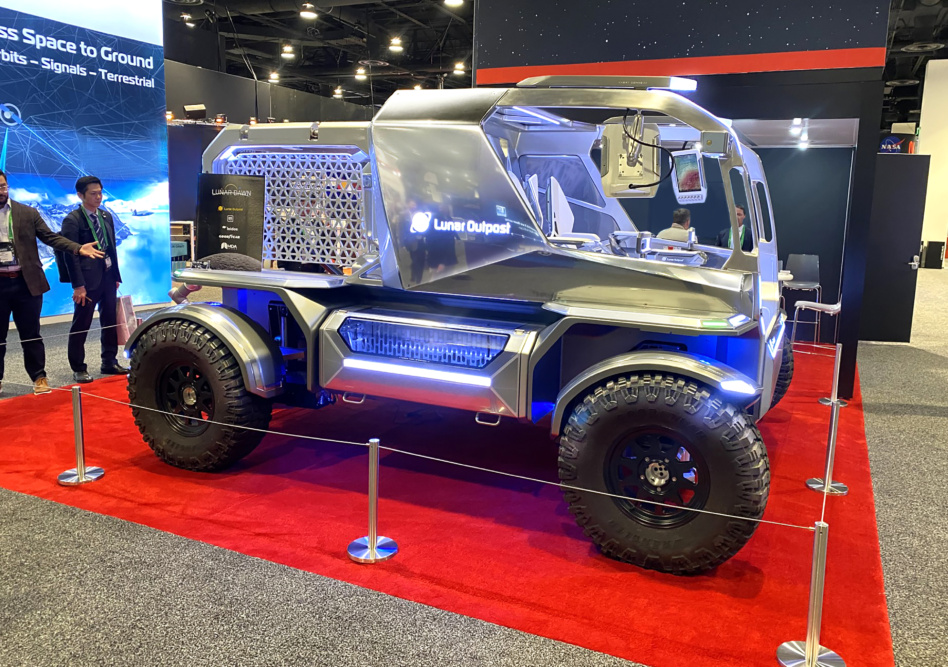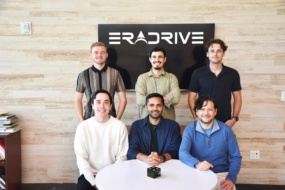Trekking across the Moon isn’t as easy as turning a key and revving the engine.
Engineers designing vehicles for the lunar surface face many challenges, including ensuring hardware can survive radiation and extreme temps, building equipment that can traverse the terrain, and reducing maintenance. After all, robotic rovers are on their own. Astronauts who travel to the Moon for science and exploration don’t want to waste time fiddling with lugnuts.
Payload spoke with several companies building next-gen lunar rovers—including Astrolab, ispace, Intuitive Machines, and Lunar Outpost—about the biggest challenges and opportunities in this sector.
Hostile environment training: It’s much harder to make vehicles for the Moon than it is for Mars, according to Jaret Matthews, the CEO of Astrolab who previously built rovers bound for the Red Planet at JPL. Compared to the Moon, Mars has a more similar day/night timing cycle to Earth, less dramatic temperature fluctuations, and just enough atmosphere to help disperse heat buildup—all things missing on the unforgiving lunar surface.
The journey to the Moon can take anywhere from a few days to a few months, depending on your route. Rovers have to survive the shock, speed, and vibration of launch, and then withstand vast amounts of cosmic radiation and wild temperature swings as each rover’s orientation to the Sun changes.
Then there’s the surface. Lunar rovers must have the power to traverse craters with deep shadows and survive the lunar night, which can last 14 Earth days on some parts of the Moon. They must have systems on-board to regulate their internal systems to keep the cool things cool, the warm things warm, and—most importantly—not interfere with any onboard scientific instruments. Rovers also have to achieve all of this on a platform that’s small and light enough to fit in the landing craft.
Making matters even worse, the Moon is covered in regolith that’s both sticky and abrasive—and Earth’s natural satellite lacks the wind and atmosphere required to blow it away. Powder can cover solar panels, making it harder for rovers to collect energy, and the dust can scratch unprotected sensors—impairing critical systems.
As Grant Anderson, CEO and president of Paragon Space Development Corp., put it at a recent MIT event, “Any mission that doesn’t bring a scientific payload to study lunar dust is a waste of time.”
Dust on my wheels: If building a rover is hard, remote controlling it from 225,000+ miles (384,000+ km) from Earth is a miracle. To start, the Moon is a terrible place for terrestrial tires. Rubber quickly melts in the Moon’s direct sunlight, and becomes brittle at temperatures that would be balmy to a Moon-being.
Tire companies, including Bridgestone and Goodyear, have partnered with lunar rover builders to develop extraterrestrial product lines—wheels and suspension systems crafted from metal to withstand lunar temperature fluctuations, avoid flats, and smoothly traverse the rocky and dusty surface. Bridgestone’s tires, which it showed off at the Space Symposium in Colorado Springs this month, have holes in the outside in a bid to also cut down on weight.
And unlike the Apollo era, where rovers tooled around over tens of miles or kilometers on GM Defense tires, modern wheels must last years and traverse thousands of miles or kilometers with minimal maintenance, Matthews said.
Adding to the mobility challenge, lunar rovers don’t yet have lunar GPS satellites for navigation, so rovers have to use localization techniques to determine their position. How exactly? The software is a closely guarded secret, according to Lunar Outpost CEO Justin Cyrus.
The Starship effect: Some of these issues can be solved with hardware and software. But to be able to carry more to the surface, these machines need outside intervention. Enter heavy-lift rockets to get more mass to the Moon. SpaceX’s Starship, for example, aims to make such lunar missions a routine event.
“The entire history of spaceflight has been extreme mass reduction and hyper reliability,” Matthews said. But being able to land 100 tons on the Moon with a high flight cadence could change the calculation, he said. “Rather than spending infinite dollars making the most elegant, mass-efficient spacecraft…make it super robust. Make it heavy.”
And for those worried about reliability: If mass constraint is no longer a concern, companies could opt to send two rovers instead, with one backing up the other.
“My hope here is we go from an era where rovers were landing on Mars once a decade at $3B to $4B apiece…to multiple times a year,” Matthews said.
New players: Lunar transit costs are already cheaper than Apollo-era highs, and a slew of commercial upstarts are shipping lunar rovers to a destination that was once the sole domain of national agencies.
Lunar Outpost became the first US company to land a rover on the Moon last month, when its Mobile Autonomous Prospecting Platform (MAPP) rover hitched a ride on Intuitive Machine’s Nova-C/Athena lander. It was Intuitive Machines’ second lunar landing.
Unfortunately, Athena’s landing went sideways. MAPP spent its sub-three-hour mission trapped inside the overturned lander—slowly losing power, and yearning for the open road.
The mission wasn’t a complete loss, however. During the seven-day commute, Lunar Outpost tested its rover systems in deep space, including autonomous systems, high-performance computing capabilities, sensors, cameras, and power. MAPP performed flawlessly.
“It really exceeded our expectations. I think it provides us a good path forward going into our second mission, which will be on [Intuitive Machines’] IM-3, and I’m sure they’ll nail that one in terms of the upright landing,” Cyrus told Payload.
Another rover is on its way to join MAPP. ispace’s Tenacious rover is expected to land in early June. The rover, built at the company’s Luxembourg office, is the first European-made rover to leave Earth, according to Julien Lamamy, managing director of ispace Europe.
The microrover will attempt to collect lunar regolith to be sold to NASA for study. While the mission is trying to achieve several technical milestones, it is also breaking ground on the legal front, setting a model for future space resource extraction missions, Lamamy said.
Riders on the Moon: Though there’s a budding commercial lunar rover industry, NASA is still primarily in the driver’s seat. The ultimate government-backed prize is the space agency’s contract to build the next-generation lunar terrain vehicles that will chauffeur Artemis astronauts around the Moon.
NASA has selected three companies—Intuitive Machines, Lunar Outpost, and the Venturi Astrolab team—to compete to build the space agency’s lunar rovers. The companies are wrapping up a year-long study period that began around April 2024, during which they refined their proposals for the LTV. Companies who move forward will be eligible to bid for a portion of $4.6B in total contracts for lunar mobility missions.
Unlike the Apollo-era Lunar Roving Vehicle, which came equipped with a 0.25-horsepower motor on each wheel and weight-saving, lawn-chair-like seats, the Artemis-era prototypes actually look like cars.
- Lunar Outpost’s version—named Eagle—has Goodyear-developed lunar tires, a flatbed cargo space, and a robotic arm envisioned as a critical tool to help build everything from lunar habitats to launch pads. It has three driving modes—crewed, remote, and fully autonomous—and is being designed to last up to 10 years without any maintenance.
- Intuitive Machines is building the Moon Reusable Autonomous Crewed Exploration Rover, or Moon RACER. The vehicle recently took an autonomous test drive on a mock lunar landscape, the company announced this week.
- Astrolab is working with Venturi on the Flexible Logistics and Exploration Rover, or FLEX, which is designed to provide last-mile delivery service not unlike the 18-wheelers that pluck shipping containers and drive them to their final destination. The rover will pick up cargo pods carrying equipment for missions ranging from scientific research to resource mining, and deliver the pods to precise locations.
When it comes to test drivers, there are very few people who had experience driving on the Moon, and fewer who are still alive after a 50-year gap (and growing) in human missions. Intuitive Machines tapped Apollo astronauts Harrison “Jack” Schmidt and Charlie Duke to take their rover for a spin and provide feedback, LTV Lead Brett Fischer told Payload.
The design of Moon RACER requires astronauts to climb on to the hood of the vehicle to swap out payloads on the roof. Engineers debated the best way to get up high—including ladders and a safety rail, in case an astronaut lost their footing. But the Apollo drivers said that in one-sixth gravity, astronauts could simply jump onto the hood—proving that first-hand experience is sometimes key. (Intuitive Machines kept the ladder, but reduced the number of rungs.
The rovers—which will operate autonomously during long periods of time when astronauts aren’t on the Moon—are key in transporting materials to build infrastructure on the lunar surface, according to officials from all three companies.
“This is what allows you to build that outpost on the Moon, and this is what allows you to build that city on Mars. You have hundreds of these vehicles that not only have the mobility aspect, but have the robotic arm and all the other key autonomy features. These robots working together can build entire cities,” Cyrus said.
Switcheroo: When NASA opted to cancel its VIPER lunar mission last year due to delays and cost overruns, the space agency’s loss was Astrolab’s gain. Matthews was watching the press conference, and saw an opening when officials said Astrobotic would still run a mission for NASA with either a mass simulator or another payload.
About 60 companies wanted to fly with Astrobotic—but Astrolab got the ride. The company Frankensteined a lunar rover on short notice, by evaluating pieces of FLEX that were technically ready. Engineers build ready-to-go tech into the FLEX Lunar Innovation Platform, or FLIP, to test out Astrolab’s LTV tech on the Moon much sooner than anticipated.
“It was kind of like in [the movie] Apollo 13, where they scatter across the table what they have on the spacecraft to create a CO2 scrubber,” Matthews said. “We looked at the hardware in development, and packed it into a smaller platform.”
FLIP will get its lunar date soon—it’s expected to lift off in December.




